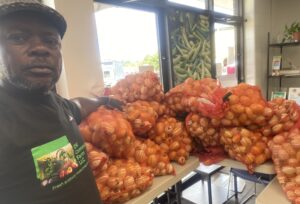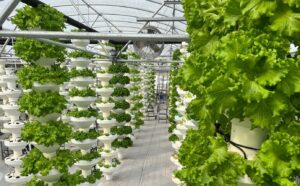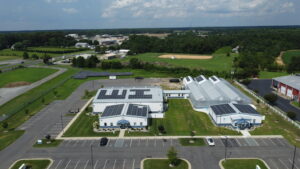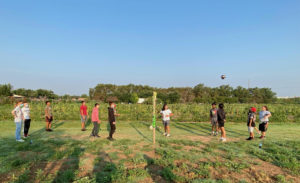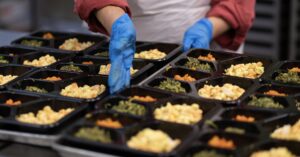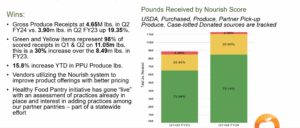Challenged by local funders to identify complex social problems and innovative ways to address them, Patti Habeck, President of Feeding America Eastern Wisconsin, found an answer in lettuce.
Along with Fork Farms of Appleton, Wis., the food bank is deploying small-scale, hydroponic farming systems at food pantries, schools and other organizations around the region. The dirt-free systems operate indoors, using lighting and nutrient-filled water to grow a sizable harvest of leafy green vegetables about every three weeks.
Besides providing fresh and healthy food, the systems strengthen people’s connections to the food they eat and how it’s produced. “We want to bring control of the fresh food system back to people who really need it the most,” said Alex Tyink, president and CEO of Fork Farms. “Systems like these can be vehicles for profound systemic change.”
Feeding America Eastern Wisconsin, which has been involved in about 25 installations so far, has seen the benefits of the hydroponic systems unfold in different ways. At pantries, lettuce can be harvested just prior to when food is distributed, eliminating the need for refrigerators or coolers to store produce, Habeck said.

At schools, the hydroponic systems help even the playing field. Unlike food received from a school pantry, lettuce grown in school is viewed as an activity or project, not a charitable donation. “It no longer matters if you’re a child in need or not,” Habeck said. “Everyone is proud to be involved. Plus, they’re more apt to eat it.”
At a domestic abuse shelter, two hydroponic machines placed by the food bank are producing leafy greens for the families in residence, while also providing therapeutic aid for residents who help nurture the plants from seed to harvest. And at a senior living center, elderly residents who are physically unable to perform traditional gardening can use the machines to touch and feel nature, even from a wheelchair.
“There are different reasons why we do different placements,” Habeck explained.
The food bank is planning to install a minimum of two, and eventually eight to twelve of the systems on its own site. Each machine takes up about nine square feet of floor space and requires access to water and a standard electrical outlet.
Vastly more efficient than traditional agriculture and even other hydroponic systems, the Fork Farm systems are the result of relentless trial and error by Tyink. The patented system uses simple concepts to embed efficiencies in the design. For example, using white panels reflects light back into the interior, enhancing the light’s impact.
The type of light bulb used, the spacing between each plant and the amount of water that trickles down into the system have all been finely tuned over the years to achieve optimal growth. “We tried to take out as much complexity as we could by baking it into the design,” Tyink said.
Tyink is not an engineer, just passionate about the power of food to change lives. His eureka moment came in 2010 when he volunteered at a rooftop garden in Brooklyn, NY, and began eating the food he had helped to grow, leading him to better eating habits and a healthier lifestyle. Before embarking on his mission to bring healthy food and its benefits to others, he had a career as an opera singer.
Of the 150 or so Fork Farms installations, about 30 are in food pantries and the rest in schools, corporate cafeterias and even homes. Increasingly, Fork Farms is fielding interest from food banks, Tyink said. In five years, he expects the systems, which cost from about $3,000 to $4,000 depending on their size, to be running in all 50 states.
While Tyink misses the people he knew while singing opera, he doesn’t miss the industry. His encounter with fresh produce at that Brooklyn rooftop garden inspired a new passion that he embraced wholeheartedly. “I just fell in love with it,” he said.

